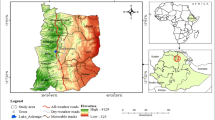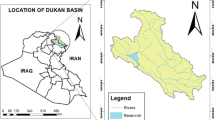Abstract
Drought is generally associated with variation in multi geomorphic-climatic variables rather than a single drought driver. Hence, it is better to consider all possible drought drivers for comprehensive spatiotemporal analysis of historical and future drought in the region with an erratic, scant, and unstable climate like the south-west agricultural region of Pakistan. This study attempted to quantify the multivariable future drought projection based on project CMIP5 climatic data under the Representative Concentration Pathway (RCP 8.5) scenario. The drought projection under the climate change scenario was performed in the historical segment (HS: 1996–2018) and two future segments (2019–2034 and 2035–2050) using trend analysis and composite drought index (CDI). The overall results indicated that temperature and evapotranspiration tend to increase with an average relative value of ≥ 5% and in the case of precipitation, the ≥ 40% (relative average) decline was observed from HS to the future, which indicated an increase in numbers of drought in near future. Moreover, drought analysis also showed that the probability of occurrence and intensity of drought would increase in the near future, especially during 2019–2034. It was observed that the sub-regions, i.e., Sindh and Balochistan, would experience more intense long-term droughts as compared to Punjab. Hence, considering the future variation of drought, substantial attention is needed for contingency planning, mitigation, and adaptation strategies to minimize the impact of probable future drought on society in drought-prone agricultural areas of Pakistan.









Similar content being viewed by others
References
Aamir E (2018) Hassan I Trend analysis in precipitation at individual and regional levels in Baluchistan, Pakistan. In: IOP Conference Series: Materials Science and Engineering, 2018. vol 1. IOP Publishing, p 012042
Abuzar MK et al (2019) Drought risk assessment in the Khushab region of Pakistan using satellite remote sensing and geospatial methods. Int J Econ Environ Geol 10:48–56
Adnan S, Ullah K, Gao S (2015) Characterization of drought and its assessment over Sindh, Pakistan during 1951–2010. J Meteorol Res 29:837–857
Ahmad I, Ambreen R, Sun Z, Deng W (2015) Winter-spring precipitation variability in Pakistan. Am J Clim Chang 4:115–139
Ahmad I, Zhang F, Tayyab M, Anjum MN, Zaman M, Liu J, Farid HU, Saddique Q (2018) Spatiotemporal analysis of precipitation variability in annual, seasonal and extreme values over upper Indus River basin. Atmos Res 213:346–360
Ahmad S, Hussain Z, Qureshi AS, Majeed R, Saleem M (2004) Drought mitigation in Pakistan: current status and options for future strategies vol 85. IWMI
Ahmed K, Sachindra D, Shahid S, Iqbal Z, Nawaz N, Khan N (2019a) Multi-model ensemble predictions of precipitation and temperature using machine learning algorithms. Atmos Res 236:104806. https://doi.org/10.1016/j.atmosres.2019.104806
Ahmed K, Shahid S, Ali RO, Harun S, Wang X (2017) Evaluation of the performance of gridded precipitation products over Balochistan Province, Pakistan. Desalination 1:14
Ahmed K, Shahid S, Bin Harun S, Wang X-j (2016) Characterization of seasonal droughts in Balochistan Province, Pakistan. Stoch Env Res Risk A 30:747–762
Ahmed K, Shahid S, Nawaz N (2018) Impacts of climate variability and change on seasonal drought characteristics of Pakistan. Atmos Res 214:364–374. https://doi.org/10.1016/j.atmosres.2018.08.020
Ahmed K, Shahid S, Nawaz N, Khan N (2019b) Modeling climate change impacts on precipitation in arid regions of Pakistan: a non-local model output statistics downscaling approach. Theor Appl Climatol 137:1347–1364
Ahmed K, Shahid S, Sachindra D, Nawaz N, Chung E-S (2019c) Fidelity assessment of general circulation model simulated precipitation and temperature over Pakistan using a feature selection method. J Hydrol 573:281–298
Ahmed M, Schmitz M (2011) Economic assessment of the impact of climate change on the agriculture of Pakistan. Bus Econ Horiz (BEH) 4:1–12
Anjum R, He X, Tanoli JI, Raza ST (2017) Contemporary temperature fluctuation in urban areas of Pakistan. Atmosphere8(1):12. https://doi.org/10.3390/atmos8010012
Anjum S, Saleem M, Cheema M, Bilal M, Khaliq T (2012) An assessment to vulnerability, extent, characteristics and severity of drought hazard in Pakistan. Pak J Sci 64:138
Anjum SA, Wang L, Salhab J, Khan I, Saleem M (2010) An assessment of drought extent and impacts in agriculture sector in Pakistan. J Food Agric Environ 8:1359–1363
Ashraf M, Routray JK (2015) Spatio-temporal characteristics of precipitation and drought in Balochistan Province. Pakistan Na Haz 77:229–254
Aslam AQ, Ahmad SR, Ahmad I, Hussain Y, Hussain MS (2017) Vulnerability and impact assessment of extreme climatic event: a case study of southern Punjab, Pakistan. Sci Total Environ 580:468–481
Chen J, Brissette FP, Leconte R (2011) Uncertainty of downscaling method in quantifying the impact of climate change on hydrology. J Hydrol 401:190–202
Chen LG, Gottschalck J, Hartman A, Miskus D, Tinker R, Artusa A (2019) Flash drought characteristics based on U.S. Drought Monitor. Atmosphere 10:498
Dai A (2011) Characteristics and trends in various forms of the Palmer Drought Severity Index during 1900–2008. J Geophys Res Atmos 116: D12115, https://doi.org/10.1029/2010JD015541
Gao Y, Wang H, Jiang D (2015) An intercomparison of CMIP5 and CMIP3 models for interannual variability of summer precipitation in Pan-Asian monsoon region. Int J Climatol 35:3770–3780
Hao Z, Singh VP (2015) Drought characterization from a multivariate perspective: a review. J Hydrol 527:668–678
Hartmann H, Andresky L (2013) Flooding in the Indus River basin—a spatiotemporal analysis of precipitation records. Glob Planet Chang 107:25–35
Hashem A, Engel B, Bralts V, Radwan S, Rashad M (2016) Performance evaluation and development of daily reference evapotranspiration model. Irrigat Drain Syst Eng 5:1–6
Hayes MJ, Wilhelmi OV, Knutson CL (2004) Reducing drought risk: bridging theory and practice. Nat Hazards Rev 5:106–113
Heim RR Jr (2002) A review of twentieth-century drought indices used in the United States. Bull Am Meteorol Soc 83:1149–1166
Huffman GJ, Bolvin DT, Nelkin EJ, Wolff DB, Adler RF, Gu G, Hong Y, Bowman KP, Stocker EF (2007) The TRMM multisatellite precipitation analysis (TMPA): quasi-global, multiyear, combined-sensor precipitation estimates at fine scales. J Hydrometeorol 8:38–55
Hussain MS, Lee S (2009) A classification of rainfall regions in Pakistan 대한지리학회지 44:605-623
Jiang R, Xie J, He H, Luo J, Zhu J (2015) Use of four drought indices for evaluating drought characteristics under climate change in Shaanxi, China: 1951–2012. Nat Hazards 75:2885–2903. https://doi.org/10.1007/s11069-014-1468-x
Keyantash JA, Dracup JA (2004) An aggregate drought index: assessing drought severity based on fluctuations in the hydrologic cycle and surface water storage. Water Resour Res 40
Khan N, Shahid S, Ahmed K, Ismail T, Nawaz N, Son M (2018) Performance assessment of general circulation model in simulating daily precipitation and temperature using multiple gridded datasets. Water 10:1793
Khan S (2019) Climate classification of Pakistan. Int J Econ Environ Geol 10:60–71
Khan SI, Hong Y, Gourley JJ, Khattak MUK, Yong B, Vergara HJ (2014) Evaluation of three high-resolution satellite precipitation estimates: potential for monsoon monitoring over. Pak Adv Space Res 54:670–684. https://doi.org/10.1016/j.asr.2014.04.017
Kogan FN (2000) Contribution of remote sensing to drought early warning. In early warning systems for drought preparedness and drought management, proceedings of an expert group meeting held on warning systems for drought preparedness and drought management. In Wilhite DA, Sivakumar MVK, Wood DA (eds) Lisbon, Portugal. 75–87
Kusunoki S, Arakawa O (2015) Are CMIP5 models better than CMIP3 models in simulating precipitation over East Asia? J Clim 28:5601–5621
Mishra AK, Singh VP (2010) A review of drought concepts. J Hydrol 391:202–216
Mishra AK, Singh VP (2011) Drought modeling – a review. J Hydrol 403:157–175. https://doi.org/10.1016/j.jhydrol.2011.03.049
Nawaz Z, Li X, Chen Y, Guo Y, Wang X, Nawaz N (2019) Temporal and spatial characteristics of precipitation and temperature in Punjab, Pakistan. Water 11:1916
Palmer WC (1965) Meteorological drought, Research paper no. 45, vol 58. US Weather Bureau, Washington, DC
Ruan Y, Liu Z, Wang R, Yao Z (2019) Assessing the performance of CMIP5 GCMs for projection of future temperature change over the Lower Mekong Basin. Atmosphere 10(2), 93; https://doi.org/10.3390/atmos10020093
Safdar F, Khokhar MF, Arshad M, Adil IH (2019) Climate change indicators and spatiotemporal shift in monsoon patterns in Pakistan. Adv Meteorol 14:8281201. https://doi.org/10.1155/2019/8281201
Salma S, Shah M, Rehman S (2012) Rainfall trends in different climate zones of Pakistan. Pak J Meteorol 9(17)
Salman SA, Shahid S, Ismail T, Ahmed K, Wang X-J (2018) Selection of climate models for projection of spatiotemporal changes in temperature of Iraq with uncertainties. Atmos Res 213:509–522
Shafer B (1982) Developemnet of a surface water supply index (SWSI) to assess the severity of drought conditions in snowpack runoff areas. In: Proceedings of the 50th Annual Western Snow Conference, Colorado State University, Fort Collins, 1982.
Sheikh MM (2001) Drought management and prevention in Pakistan. In: COMSATS 1st meeting on water resources in the south: present scenario and future prospects, Islamabad. pp 1-2
Sivakumar MV, Motha R, Wilhite D, Wood D (2011) Agricultural drought indices. Proceedings of an Expert Meeting: 2-4 June, 2010, Murcia, Spain. WMO,
Vicente-Serrano SM, Beguería S, López-Moreno JI (2010) A multiscalar drought index sensitive to global warming: the standardized precipitation evapotranspiration index. J Clim 23:1696–1718
Waseem M, Ahmad I, Mujtaba A, Tayyab M, Si C, Lü H, Dong X (2020) Spatiotemporal dynamics of precipitation in southwest arid-agriculture zones of Pakistan. Sustainability 12:2305
Waseem M, Ajmal M, Kim T-W (2015) Development of a new composite drought index for multivariate drought assessment. J Hydrol 527:30–37. https://doi.org/10.1016/j.jhydrol.2015.04.044
Wilhite DA (2000) Drought as a natural hazard: concepts and definitions . Published in Drought: A Global Assessment, Vol. I, edited by Donald A. Wilhite, 3–18, London: Routledges
Xie H, Ringler C, Zhu T, Waqas A (2013) Droughts in Pakistan: a spatiotemporal variability analysis using the Standardized Precipitation. Index Water In 38:620–631
Zargar A, Sadiq R, Naser B, Khan FI (2011) A review of drought indices. Environ Rev 19:333–349
Funding
This study is financially supported by the Higher Education Commission, Pakistan under Startup Research Grant (SRGP-1695).
Author information
Authors and Affiliations
Corresponding author
Ethics declarations
Conflict of interest
The authors declare no competing interests.
Additional information
Responsible Editor: Zhihua Zhang
Rights and permissions
About this article
Cite this article
Waseem, M., Ajmal, M., Ahmad, I. et al. Projected drought pattern under climate change scenario using multivariate analysis. Arab J Geosci 14, 544 (2021). https://doi.org/10.1007/s12517-021-06860-7
Received:
Accepted:
Published:
DOI: https://doi.org/10.1007/s12517-021-06860-7




